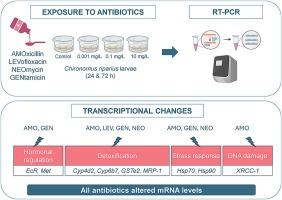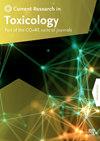Molecular response of Chironomus riparius to antibiotics
IF 2.9
Q2 TOXICOLOGY
引用次数: 0
Abstract
Antibiotics, like other pharmaceuticals, are continuously released into the environment as a result of human activities. Although designed to target harmful bacteria, they can also affect non-target organisms in aquatic ecosystems. Standard toxicological tests often fail to detect the subtle or long term antibiotic-induced effects, but newer methods are providing valuable insights into the molecular pathways and physiological responses they affect. Chironomus riparius, a dipteran with aquatic larvae, is widely used in toxicological testing due to its sensitivity to various toxicants. However, little is known about the molecular effects of antibiotics on this species.
This study investigated the gene expression profile of C. riparius in response to antibiotics from three classes − aminoglycosides, fluoroquinolones and penicillin. Fourth instar larvae were exposed to concentrations of 0.001, 0.1 and 10 mg/L for 24 and 72 h. The expression of genes involved in hormonal regulation, detoxification, stress response and DNA repair was analysed. The results showed that all antibiotics altered mRNA levels, with three of the four (amoxicillin, neomycin and levofloxacin) downregulating genes at 24 h and upregulating them at 72 h. Genes affected by gentamicin showed the opposite trend.
These transcriptional changes in response to different antibiotics highlight the complexity of the regulatory mechanisms involved in development, detoxification, stress response and DNA repair in aquatic insects. Further research is needed to better understand the molecular effects of antibiotics on this species.

河岸手蛾对抗生素的分子反应
抗生素和其他药物一样,由于人类活动而不断地释放到环境中。虽然它们的设计目标是有害细菌,但它们也可以影响水生生态系统中的非目标生物。标准的毒理学测试通常无法检测到抗生素引起的微妙或长期的影响,但较新的方法正在为它们影响的分子途径和生理反应提供有价值的见解。河岸手蛾是一种具有水生幼虫的双翅目动物,由于其对各种毒物敏感而被广泛用于毒理学检测。然而,抗生素对该物种的分子效应知之甚少。本研究研究了三种抗生素(氨基糖苷类、氟喹诺酮类和青霉素)对河岸链球菌基因表达谱的影响。将4龄幼虫分别置于0.001、0.1和10 mg/L浓度下处理24和72 h,分析其激素调节、解毒、应激反应和DNA修复相关基因的表达情况。结果表明,所有抗生素均改变mRNA水平,其中阿莫西林、新霉素和左氧氟沙星3种基因在24 h下调,在72 h上调。庆大霉素影响基因的趋势相反。这些针对不同抗生素的转录变化凸显了水生昆虫发育、解毒、应激反应和DNA修复等调控机制的复杂性。需要进一步研究以更好地了解抗生素对该物种的分子效应。
本文章由计算机程序翻译,如有差异,请以英文原文为准。
求助全文
约1分钟内获得全文
求助全文
来源期刊

Current Research in Toxicology
Environmental Science-Health, Toxicology and Mutagenesis
CiteScore
4.70
自引率
3.00%
发文量
33
审稿时长
82 days
 求助内容:
求助内容: 应助结果提醒方式:
应助结果提醒方式:


